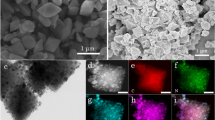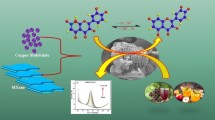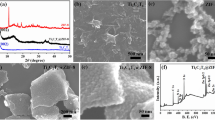Abstract
Heterostructured TiO2@MXene rich in oxygen vacancies defects (VO-TiO2@MXene) has been developed to construct an electrochemical sensing platform for imidacloprid (IMI) determination. For the material design, TiO2 nanoparticles were firstly in situ grown on MXene and used as a scaffolding to prevent the stack of MXene nanosheets. The obtained TiO2@MXene heterostructure displays excellent layered structure and large specific surface area. After that, electrochemical activation is utilized to treat TiO2@MXene, which greatly increases the concentration of surface oxygen vacancies (VOs), thereby remarkably enhancing the conductivity and adsorption capacity of the composite. Accordingly, the prepared VO-TiO2@MXene displays excellent electrocatalytic activity toward the reduction of IMI. Under optimum conditions, cyclic voltammetry and linear sweep voltammetry techniques were utilized to investigate the electrochemical behavior of IMI at the VO-TiO2@MXene/GCE. The proposed sensor based on VO-TiO2@MXene presents an obvious reduction peak at -1.05 V(vs. Hg|Hg2Cl2) with two linear ranges from 0.07 - 10.0 μM and 10.0 - 70.0 μM with a detection limit of 23.3 nM (S/N= 3). Furthermore, the sensor provides a reliable result for detecting IMI in fruit and vegetable samples with a recovery of 97.9-103% and RSD≤ 4.3%.
Graphical abstract

A sensitive electrochemical sensing platform was reported for imidacloprid (IMI) determination based on heterostructured TiO2@MXene rich in oxygen vacancy defects.








Similar content being viewed by others
References
Zhangsun H, Wang Q, Xu Z, Wang J, Wang X, Zhao Y, Zhang H, Zhao S, Li L, Li Z, Wang (2022) NiCu nanoalloy embedded in N-doped porous carbon composite as superior electrochemical sensor for neonicotinoid determination. Food Chem 384:132607-132617. https://doi.org/10.1016/j.foodchem.2022.132607.
Kateshiya MR, Malek NI, Kailasa SK (2020) Facile synthesis of highly blue fluorescent tyrosine coated molybdenum oxide quantum dots for the detection of imidacloprid pesticide. J Mol Liq 319:114329–114337. https://doi.org/10.1016/j.molliq.2020.114329
Sun Y, Zhang N, Han C, Chen Z, Zhai X, Li Z, Zheng K, Zhu J, Wang X, Zou X, Huang X, Shi J (2021) Competitive immunosensor for sensitive and optical anti-interference detection of imidacloprid by surface-enhanced Raman scattering. Food Chem. 358:129898–129906. https://doi.org/10.1016/j.foodchem.2021.129898
Xie W, Ju Y, Zhang J, Yang Y, Zeng Y, Wang H, Li L (2022) Highly sensitive and specific determination of imidacloprid pesticide by a novel Fe3O4@ SiO2@ MIPIL fluorescent sensor. Anal. Chim. Acta. 1195:339449–339458. https://doi.org/10.1016/j.aca.2022.339449
Wang F, Zhang X, Zhi H, Feng L (2023) Prussian blue analogues based polymer monolith with amphiphilic interface to construct highly selective and sensitive imidacloprid chemosensor. Talanta. 253:123870–123876. https://doi.org/10.1016/j.talanta.2022.123870
Baskaran S, Kookana RS, Naidu R (1997) Determination of the insecticide imidacloprid in water and soil using high-performance liquid chromatography. J. Chromatogr. A. 787:271–275. https://doi.org/10.1016/s0021-9673(97)00652-3
Mehta VN, Ghinaiya N, Rohit JV, Singhal RK, Basu H, Kailasa SK (2022) Ligand chemistry of gold, silver and copper nanoparticles for visual read-out assay of pesticides: a review. Trends Anal. Chem. 153:116607–116632. https://doi.org/10.1016/j.trac.2022.116607
Laochai T, Yukird J, Promphet N, Qin J, Chailapakul O, Rodthongkum N (2022) Non-invasive electrochemical immunosensor for sweat cortisol based on L-cys/AuNPs/MXene modified thread electrode. Biosens. Bioelectron. 203:114039–114049. https://doi.org/10.1016/j.bios.2022.114039
Hou Y, Long N, Jia B, Liao X, Yang M, Fu L, Zhou L, Sheng P, Kong W (2022) Development of a label-free electrochemical aptasensor for ultrasensitive detection of ochratoxin A. Food Control. 135:108833–108839. https://doi.org/10.1016/j.foodcont.2022.108833
Ma X, Tang K, Lu K, Zhang C, Shi W, Zhao W (2021) Structural engineering of hollow microflower-like CuS@C hybrids as versatile electrochemical sensing platform for highly sensitive hydrogen peroxide and hydrazine detection, ACS Appl. Mater. Interfaces. 13:40942–40953. https://doi.org/10.1021/acsami.1c11747
Chen S, Xu J, Shi M, Yu Y, Xu Q, Duan X, Gao Y, Lu L (2021) Polydopamine bridged MXene and NH2-MWCNTs nanohybrid for high-performance electrochemical sensing of Acetaminophen. Appl. Surf. Sci. 570:151149–151159. https://doi.org/10.1016/j.apsusc.2021.151149
Zou J, Qian W, Li Y, Yu Q, Yu Y, Chen S, Qu F, Gao Y, Lu L (2021) Multilayer activated biochar/UiO-66-NH2 film as intelligent sensing platform for ultra-sensitive electrochemical detection of Pb2+ and Hg2+. Appl. Surf. Sci. 569:151006–151019. https://doi.org/10.1016/j.apsusc.2021.151006
Ma X, Tu X, Gao F, Xie Y, Huang X, Fernandez C, Qu F, Liu G, Lu L, Yu Y (2020) Hierarchical porous MXene/amino carbon nanotubes-based molecular imprinting sensor for highly sensitive and selective sensing of fisetin. Sens. Actuators B Chem. 309:127815–127825. https://doi.org/10.1016/j.snb.2020.127815
Zhong W, Zou J, Yu Q, Gao Y, Qu F, Liu S, Zhou H, Lu L (2023) Ultrasensitive indirect electrochemical sensing of thiabendazole in fruit and water by the anodic stripping voltammetry of Cu2+ with hierarchical Ti3C2Tx-TiO2 for signal amplification. Food Chem. 402:134379–134387. https://doi.org/10.1016/j.foodchem.2022.134379
Huang H, Song Y, Li N, Chen D, Xu Q, Li H, He J, Lu J (2019) One-step in-situ preparation of N-doped TiO2@C derived from Ti3C2 MXene for enhanced visible-light driven photodegradation. Appl. Catal. B Environ. 251:154–161. https://doi.org/10.1016/j.apcatb.2019.03.066
Zhang Y, Zhao Z, Luo C, Wu X, Chen W (2022) Toward understanded the electrochemical capacitance mechanism of MXene by intercalation of inorganic ions and organic macromolecular ions. Appl. Surf. Sci. 578:152030–152036. https://doi.org/10.1016/j.apsusc.2021.152030
Rajavel K, Shen S, Ke T, Lin D (2021) Photocatalytic and bactericidal properties of MXene-derived graphitic carbon-supported TiO2 nanoparticles. Appl. Surf. Sci. 538:148083–148098. https://doi.org/10.1016/j.apsusc.2020.148083
Li P, Song Z, Yang M, Chen S, Xiao X, Duan W, Li L, Huang X (2020) Electrons in oxygen vacancies and oxygen atoms activated by Ce3+/Ce4+ promote high-sensitive electrochemical detection of Pb solution (II) over Ce-doped α-MoO3 catalysts. Anal. Chem. 92:16089–16096. https://doi.org/10.1021/acs.analchem.0c03725
Sun Y, Li J, Xie F, Wei Y, Yang M (2020) Ruthenium-loaded cerium dioxide nanocomposites with rich oxygen vacancies promoted the highly sensitive electrochemical detection of Hg (II). Sens. Actuators B Chem. 320:128355–128367. https://doi.org/10.1016/j.snb.2020.128355
Kumar J, El-Bahy SM, Azab IHE, Elnaggar AY, Ibrahim MM, Soomro RA, Karakus S (2022) 3D prickle-like hierarchical NiO nanostructures with oxygen vacancies for electrochemical detection of enrofloxacin antibiotics. Applied Physics A. 128:693–704. https://doi.org/10.1007/s00339-022-05857-7
Zhang H, Li P, Zhou H, Xu J, Jiang Q, Hadden JHL, Wang Y, Wang M, Chen S, Xie F, Riley DJ (2022) Unravelling the synergy of oxygen vacancies and gold nanostars in hematite for the electrochemical and photoelectrochemical oxygen evolution reaction. Nano Energy. 94:106968–106978. https://doi.org/10.1016/j.nanoen.2022.106968
Ma Y, Wang N, Chen J, Chen C, San H, Chen J, Cheng Z (2018) Betavoltaic enhancement using defect-engineered TiO2 nanotube arrays through electrochemical reduction in organic electrolytes, ACS Appl. Mater. Interfaces. 10:22174–22181. https://doi.org/10.1021/acsami.8b05151
Cai J, Zhu Y, Liu D, Meng M, Hu Z, Jiang Z (2015) Synergistic effect of titanate-anatase heterostructure and hydrogenation-induced surface disorder on photocatalytic water splitting. ACS Catal. 5:1708–1716. https://doi.org/10.1021/acscatal.5b00055
Li S, Xu Q, Xu J, Yan G, Zhang Y, Li S, Yin L (2022) Engineering Co2+/Co3+ redox activity of Ni-mediated porous Co3O4 nanosheets for superior Hg (II) electrochemical sensing: insight into the effect of valence change cycle and oxygen vacancy on electroanalysis. Sens. Actuators B Chem. 354:131095–131106. https://doi.org/10.1016/j.snb.2021.131095
Zuo F, Wang L, Wu T, Zhang Z, Borchardt D, Feng P (2010) Self-doped Ti3+ enhanced photocatalyst for hydrogen production under visible light. J. Am. Chem. Soc. 132:11856–11857. https://doi.org/10.1021/ja103843d
Ge L, Liu Q, Jiang D, Ding L, Wen Z, Guo Y, Ding C, Wang K (2019) Oxygen vacancy enhanced photoelectrochemical performance of Bi2MoO6/B, N co-doped graphene for fabricating lincomycin aptasensor. Biosens. Bioelectron. 135:145–152. https://doi.org/10.1016/j.bios.2019.04.022
Wang X, Li M, Yang S, Shan J (2020) A novel electrochemical sensor based on TiO2-Ti3C2TX/CTAB/chitosan composite for the detection of nitrite. Electrochim. Acta. 359:136938–136948. https://doi.org/10.1016/j.electacta.2020.136938
Lv Y, Sun J, Qiao S, Zhang M, Li J (2021) A facile, inexpensive and green electrochemical sensor for sensitive detection of imidacloprid residue in rice using activated electrodes. Anal. Methods. 13:3649–3658. https://doi.org/10.1039/d1ay00984b
Tu X, Gao F, Ma X, Zou J, Yu Y, Li M, Qu F, Huang X, Lu L (2020) Mxene/carbon nanohorn/β-cyclodextrin-metal-organic frameworks as high-performance electrochemical sensing platform for sensitive detection of carbendazim pesticide. J. Hazard. Mater. 396:122776–122785. https://doi.org/10.1016/j.jhazmat.2020.122776
Zhang S, Liu Y, Feng M, Zhang B, Yu T, Xu S, Sun G, Wang D (2021) Leaf-like MXene nanosheets intercalated TiO2 nanorod array photoelectrode with enhanced photoelectrochemical performance. J. Power Sources. 484:229236–229244. https://doi.org/10.1016/j.jpowsour.2020.229236
Miao Z, Wang G, Zhang X, Dong X (2020) Oxygen vacancies modified TiO2/Ti3C2 derived from MXenes for enhanced photocatalytic degradation of organic pollutants: the crucial role of oxygen vacancy to schottky junction. Appl. Surf. Sci. 528:146929–146940. https://doi.org/10.1016/j.apsusc.2020.146929
Keerakit K, Kamonwad N (2023) Microporous carbon for fast and simple electrochemical detection of imidacloprid insecticide in fruit and water samples. RSC Adv. 13:4532–4541. https://doi.org/10.1039/D3RA00192J
Wang Q, Li R, Zhao Y, Zhe T, Bu T, Liu Y, Sun X, Hu H, Zhang M, Zheng X, Wang L (2020) Surface morphology-controllable magnetic covalent organic frameworks: a novel electrocatalyst for simultaneously high-performance detection of p-nitrophenol and o-nitrophenol. Talanta. 219:121255–121314. https://doi.org/10.1016/j.talanta.2020.121255
Zhao Y, Zheng X, Wang Q, Zhe T, Bai Y, Bu T, Zhang M, Wang L (2020) Electrochemical behavior of reduced graphene oxide/cyclodextrins sensors for ultrasensitive detection of imidacloprid in brown rice. Food Chem. 333:127495–127504. https://doi.org/10.1016/j.foodchem.2020.127495
Li R, Zhe T, Li M, Li J, Li F, Bai F, Li L, Ma K, Shen S, Wang L (2022) Simple high-temperature annealing affords commercial carbon cloth with enhanced electrochemical performance for highly sensitive detection of imidacloprid. J. Pharmaceut. Biomed. Anal. 219:114963–114970. https://doi.org/10.1016/j.jpb.2022.114963
de Cássia Silva Luz R, Damos FS, de Oliveira AB, Beck J, Kubota LT (2004) Voltammetric determination of 4-nitrophenol at a lithium tetracyanoethylenide (LiTCNE) modified glassy carbon electrode. Talanta. 64:935–942. https://doi.org/10.1016/j.talanta.2004.04.010
Zhang W, Liu C, Zou X, Zhang H, Xu Y (2019) A β-CD/MWCNT-modified-microelectrode array for rapid determination of imidacloprid in vegetables, Food Anal. Methods. 12:2326–2333. https://doi.org/10.1007/s12161-019-01580-x
Rashed MA, Faisal M, Alsareii SA, Alsaiari M, Jalalah M, Harraz FA (2022) Highly sensitive and selective electrochemical sensor for detecting imidacloprid pesticide using novel silver nanoparticles/mesoporous carbon/hematite ore ternary nanocomposite. J. Environ. Chem. Eng. 10:108364–108378. https://doi.org/10.1016/j.jece.2022.108364
Tang F, Hua Q, Wang X, Luan F, Wang L, Li Y, Zhuang X, Tian C (2022) A novel electrochemiluminescence sensor based on a molecular imprinting technique and UCNPs@ ZIF-8 nanocomposites for sensitive determination of imidacloprid. Analyst. 147(17):3917–3923. https://doi.org/10.1039/d2an01005d
Luo J, Li S, Wu Y, Pang C, Ma X, Wang M, Zhang C, Zhi X, Li B (2022) Electrochemical sensor for imidacloprid detection based on graphene oxide/gold nano/β-cyclodextrin multiple amplification strategy. Microchem. J. 183:107979. https://doi.org/10.1016/j.microc.2022.107979
Bhattu M, Verma M, Wani AA, Bharatam PV, Sareen S, Kathuria D (2023) Tuning of (E)-(4-fluorophenyl)-1, 1-diamino-2, 3-diazabuta-1, 3-diene nanostructures for the selective detection of imidacloprid. Environ. Res. 216:114494. https://doi.org/10.1016/j.envres.2022.114494
Funding
This work is funded by the National Natural Science Foundation of China (22064010 and 51862014), the Natural Science Foundation of Jiangxi Province (20212BAB 203019 and 20202ACBL213009), Natural Science Foundation of Nanchang City (No. 2018CXTD014), the Natural Science Foundation of Hunan Province (2022JJ30419 and 2022JJ30418), and the Research Foundation of Education Bureau of Hunan Province (19B384).
Author information
Authors and Affiliations
Corresponding authors
Ethics declarations
Conflict of interest
The authors declare no competing interests.
Additional information
Publisher’s note
Springer Nature remains neutral with regard to jurisdictional claims in published maps and institutional affiliations.
Supplementary information
Rights and permissions
Springer Nature or its licensor (e.g. a society or other partner) holds exclusive rights to this article under a publishing agreement with the author(s) or other rightsholder(s); author self-archiving of the accepted manuscript version of this article is solely governed by the terms of such publishing agreement and applicable law.
About this article
Cite this article
Yang, J., Deng, C., Zhong, W. et al. Electrochemical activation of oxygen vacancy-rich TiO2@MXene as high-performance electrochemical sensing platform for detecting imidacloprid in fruits and vegetables. Microchim Acta 190, 146 (2023). https://doi.org/10.1007/s00604-023-05734-x
Received:
Accepted:
Published:
DOI: https://doi.org/10.1007/s00604-023-05734-x




